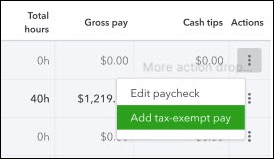Set up and track Alabama overtime exemption
by Intuit• Updated 4 months ago
Learn how to set up QuickBooks Payroll to track overtime pay exempt from Alabama (AL) withholding tax.
Effective January 1, 2024, if an hourly employee works more than 40 hours in a week, the pay from those extra hours is exempt from AL income tax.
Here’s more about the state law, how to track it and report it in QuickBooks Online Payroll and QuickBooks Desktop Payroll.
Understand AL overtime exemption
- Overtime pay is exempt only for full-time hourly employees. It doesn’t include salaried employees.
- Work performed over 40 hours in a week is exempt, whether it’s paid as overtime or regular pay.
- The exemption applies to all paycheck dates on or after January 1, 2024 through June 30, 2025.
- Overtime pay earned in excess of 8 hours a day under collective bargaining agreements aren’t exempt if your employees don’t work more than 40 hours in the week.
- This info needs to be reported on either a monthly or quarterly basis, and on Form W-2.
Find out more on the Alabama Department of Revenue website.
Track the AL overtime exemption
| Note: The AL-OT Withholding exempt item will show 0.00 on the employee's paychecks / pay stubs. This item is for tracking/filing purposes only. To see the wage totals, run a Payroll Item Detail report. |
Select your product below for instructions.
| Note: Not sure which payroll service you have? Here's how to find your payroll service. |
Report the tax-exempt amounts to AL
This info needs to be reported on either a monthly (AL A-6) or quarterly (AL A-1) basis, and on Form W-2.
For 2023, there’s a one-time reporting requirement. The report needs the total number of full-time hourly employees who were paid overtime, and the total amount of overtime paid in calendar year 2023.
Sign in now for personalized help
See articles customized for your product and join our large community of QuickBooks users.
More like this
- Set up and manage payroll schedulesby QuickBooks•8177•Updated May 10, 2024
- Set up and track time off in payrollby QuickBooks•596•Updated 1 month ago
- Add overtime pay to an employeeby QuickBooks•253•Updated 1 month ago
- Set up, change, or delete employee-paid payroll deductionsby QuickBooks•4285•Updated April 12, 2024
